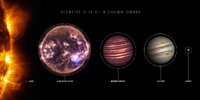You are using an out of date browser. It may not display this or other websites correctly.
You should upgrade or use an alternative browser.
You should upgrade or use an alternative browser.
Space objects size
- Thread starter Ellipse
- Start date
When the Sun and its Companion start to play tango, Earth will realize music doesn't only come from its rock concerts. 

SHNAGFNAY
Jedi Master
From session 11 July 1998:
Q: (A) So, we have the idea. Next question concerning this companion star; we were told that its mass is less than the sun, can we have a figure on how much less?
A: 56 percent of the mass of the sun.
Q: (A) Okay, if this is really so, then when it really starts to approach the solar system, and they rotate in tandem, it means that the sun will really start to feel its gravity, and because of this, the solar system will start to move with respect to other stars, so all the constellations will shift, is this correct?
A: More like a slight "wobble" effect.
Q: (L) Will that be perceptible to us here on the Earth?
A: Only through measurements.
Thank you for finding that back!From session 11 July 1998:
Look like there's a kind of correlation between what the C's said and the picture. We have to keep in mind that mass of celestial planets/stars is not always proportional with their size. So it look like the brown dwarf is more dense than our sun.
I was thinking to ask the C's about the companion star and densities (3D/4D). I wonder if a star can oscillate between densities so it will make it invisible at some periods. But I have to check if not asked before.

